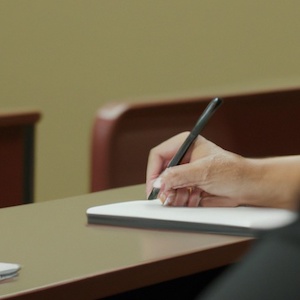By Dr. Ken Broda-Bahm:

In our increasingly digital world, the idea of taking notes the old-fashioned way with paper and pen can feel quaint. Yet, many of us still do it. For those jurors who are permitted to take notes, they are almost certainly doing it the old-fashioned way. New research, however, continues to demonstrate the cognitive benefits of that method. A very recent study (Van der Well & Van der Meer, 2024) looked at the brain activity of students writing versus using a keyboard, and found that writing by hand engages more elaborate brain connectivity, and activates more of the neural patterns specifically linked to comprehension and memory formation. The research has been used to argue that children should still be taught to handwrite and to draw, but it also helps build the case for note-taking in other contexts, including the jury box.
Looking at this research, Brooklyn-based science journalist Charlotte Hu, wrote a piece for Scientific American, “Why Writing by Hand is Better for Memory and Learning,” looking into some of the reasons for a cognitive advantage from handwriting. The short answer, she says, is that “engaging the fine motor system to produce letters by hand has positive effects on learning and memory.” It is now easier than ever to take notes using something other than handwriting, and if you’ve been in a law school recently, you’ve likely seen a full classroom tapping away on open laptops. Many schools are even moving away from teaching cursive. But for note-takers in and out of a jury box, handwriting still makes sense.
Why Would Handwriting Be Better for the Brain?
Part of it has to do with speed. When a reasonably proficient typist is taking notes using a keyboard, then you can record a lot, and that encourages the notetaker to just write what they’re hearing. The slower speed of hand-writing notes, in contrast, forces the notetaker to synthesize and summarize, and that greater activity improves comprehension and engagement with the material.
The other and perhaps more significant advantage of note-taking, however, stems from the muscles in your hand. The Scientific American article quotes Vanderbilt neuroscientist Sophia Vinci-Booher:
“’As you’re drawing a letter or writing a word, you’re taking this perceptual understanding of something and using your motor system to create it.’ That creation is then fed back into the visual system, where it’s processed again—strengthening the connection between an action and the images or words associated with it. It’s similar to imagining something and then creating it: when you materialize something from your imagination (by writing it, drawing it, or building it), this reinforces the imagined concept and helps it stick in your memory.”
Jurors Should Be Able to Take Notes in Every Courtroom
One source, U.S. Legal, indicates that in more than a third of American courtrooms, juror note-taking is still not permitted. This is based on a dated yet durable idea that note-taking might distort the deliberation process by elevating some evidence over other evidence based on what ends up being recorded. While that has never been empirically supported, recording nothing seems to be far too high a price to pay in terms of jury understanding.
In a recent trial in Ohio where the judge did not allow note-taking, I watched a frustrated panel fight to maintain attention while opposing counsel walked them through columns of numbers on detailed charts. Yes, they could watch it on a screen, but they could do nothing to engage with it or record it for later use. Whatever point counsel was trying to make was almost certainly lost.
The research suggests that jurors, and other students, who are writing as they listen are going to enjoy a richer engagement and a better understanding of the material.
We Should Also Continue to Take Notes by Hand
In my work, I’m often trying to capture as much information as I can from what I’m seeing. Watching a jury deliberate in a mock trial, for example, there is a lot going on. When I’m typing, I can capture a lot, and those notes are easier to share when I’m done. But I do find that when I take notes by hand, they’re better and more thoughtful.
In court during jury selection, I went through a phase where I typed notes from the panelists into a specialized computer app we had developed. It had some advantages, but over time I became self-conscious of the noise that even a quiet keyboard would make in a courtroom.
These days, if you see me in court, you will see me with an iPad Pro combined with an Apple pencil scribbling away on what the potential jurors are saying. To me, that method combines the connectedness of electronics (which is great for receiving social media information from researchers outside the courtroom, and for permitting an infinite writing surface rather than a cramped Post-it note) with the old-fashioned ability to write down (and circle, star, and underline) the notes as I go.
Even in a fast-paced digital world, there is still a lot of room for the time-ordered practice of listening while synthesizing and summarizing our thoughts by hand.
____________________
Other Posts on Note-Taking:
- Let the Jurors Take and Review Notes
- Keep Handwriting Your Notes
- Remember, Jurors Are Always Forgetting
____________________
Van der Weel, F. R., & Van der Meer, A. L. (2024). Handwriting but not typewriting leads to widespread brain connectivity: a high-density EEG study with implications for the classroom. Frontiers in Psychology, 14, 1219945.
Image credit: Shutterstock, used under license